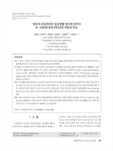

-
 * 본 문서는 배포용으로 복사 및 편집이 불가합니다.
* 본 문서는 배포용으로 복사 및 편집이 불가합니다.
미리보기
서지정보
· 발행기관 : 대한작업치료학회
· 수록지 정보 : 대한작업치료학회지 / 21권 / 3호
· 저자명 : 신원호, 권정이, 박흥석, 지선하, 정병록, 남정모
초록
목적 : 영유아 뇌성마비 아동과 정상발달 아동을 대상으로 K-MBI와 한글 PEDI를 실시하여 영유아 뇌성마비의 일상생활 평가에 있어서 두 평가 도구의 적합성을 비교하고자 하였다. 연구방법 : 만 1세부터 5세 미만의 뇌성마비 아동 66명과 정상 발달 아동 68명을 대상으로 하였다. 일상생활활동의 검사도구인 K-MBI와 한글 PEDI는 모두 검사자 1명에 의해서 시행되었고. 통계분석은 SPSS version 18.0과 MedCalc version 12.3을 사용하였다. 뇌성마비군과 정상군에서 두 평가의 변별력을 비교하기 위해 Receiver Operating Characteristics (ROC) 분석을 이용하였고, 두 집단 간에 K-MBI 점수와 한글 PEDI 점수를 비교하기 위해 독립표본 t 검정을 실시하였다. 결과 : K-MBI와 한글 PEDI 모두 정상군과 뇌성마비군에서 유의한 차이를 보였으며, K-MBI의 경우 보행, 의자/침대 이동, 계단 오르기 순으로 큰 차이를 보였다. 한글 PEDI에서는 기능적 기술 부분과 보호자 도움 부분 양측에서 이동 영역, 신변처리 영역, 사회적 기능 영역 순으로 큰 차이를 보였다. 또한 두 평가의 적합성 비교를 위하여 Area Under the ROC Curves (AUC) 넓이 차이를 비교한 결과 총합, 신변처리 영역, 이동 영역 모두에서 한글 PEDI가 K-MBI보다 넓었다. 결론 : 영유아 뇌성마비 아동의 장애 유무를 변별하는데 한글 PEDI가 현재 뇌병변 장애 판정 기준으로 사용되는 K-MBI보다 높은 변별력을 가진다. 임상에서 영유아 뇌성마비의 뇌병변 장애등급 판정시 아동의 일상생활을 보다 적절히 평가 할 수 있는 도구로 보완하거나 대체하는 것이 필요하다.영어초록
Objective : This study aimed to apply the Korean version of the Modified Barthel Index (K-MBI) and the Korean version of the Pediatric Evaluation of Disability Inventory (PEDI) on infants with cerebral palsy, and on non-disabled infants, to compare the appropriateness of these tools when evaluating the activities of daily living in infants with cerebral palsy. Methods : The subjects of this study included 66 infants with cerebral palsy and 68 non-disabled infants aged between 1 and 5. The data collected were statistically analyzed using SPSS version 18.0 and MedCalc version 12.3. For a discriminative power comparison, a receiver operating characteristics (ROC) analysis was utilized. An independent t-test was conducted to compare the scores between the two groups. Results : Both the K-MBI and the Korean version of the PEDI showed a statistically significant difference between infants with cerebral palsy and non-disabled infants. In the case of the K-MBI, the difference was the greatest for“ ambulation,”followed by“ chair/bed transfer”and“ stair up/down.”The Korean version of the PEDI, on the other hand, showed the greatest difference in the mobility category, followed by the selfcare and social function categories in the Korean version of the PEDI. The AUC comparison, which was conducted to compare the discriminative ability of the two tools, determined that its total, functional skills, and caregiver assistance for the Korean version of the PEDI were significantly broader than for the K-MBI. Conclusion : The Korean version of the PEDI had a better discriminative power than the K-MBI, which is currently used as a criterion to determine the level of disabilities of infants with brain lesions. In clinical practice, it is necessary to compliment or replace the current methods used to assess an infant’s development through the use of tools that more properly diagnose and evaluate the infant’s level of disability.참고자료
· 없음태그
-
자료후기
-
자주묻는질문의 답변을 확인해 주세요

꼭 알아주세요
-
본 학술논문은 (주)코리아스칼라와 각 학회간에 저작권계약이 체결된 것으로 AgentSoft가 제공 하고 있습니다.
본 저작물을 불법적으로 이용시는 법적인 제재가 가해질 수 있습니다. -
해피캠퍼스는 구매자와 판매자 모두가 만족하는 서비스가 되도록 노력하고 있으며, 아래의 4가지 자료환불 조건을 꼭 확인해주시기 바랍니다.
파일오류 중복자료 저작권 없음 설명과 실제 내용 불일치 파일의 다운로드가 제대로 되지 않거나 파일형식에 맞는 프로그램으로 정상 작동하지 않는 경우 다른 자료와 70% 이상 내용이 일치하는 경우 (중복임을 확인할 수 있는 근거 필요함) 인터넷의 다른 사이트, 연구기관, 학교, 서적 등의 자료를 도용한 경우 자료의 설명과 실제 자료의 내용이 일치하지 않는 경우
“대한작업치료학회지”의 다른 논문도 확인해 보세요!
-
동영상을 이용한 자기관찰이 자폐 범주성 장애 아동의 문제행동에 미치는 영향 10 페이지
목적 : 본 연구는 자폐 범주성 장애 아동을 대상으로 한 자기관찰법 적용이 문제행동의 감소에 영향을 미치는지를 알아보고자 하였다. 연구방법 : 연구대상은 자폐 범주성 장애로 진단받은 초등학교 저학년 아동 3명이었으며, 개별실험연구의 ABA설계를 사용하였다. 연구과정은 총 7주간 12회기로 이루어졌으며, 자기관찰은 자신의 이전 회기 동영상을 편집없이 10분 .. -
휠체어 자세 교육이 편마비 환자의 앉은 자세 및 만족도에 미치는 영향 12 페이지
목적 : 본 연구는 수동 휠체어를 사용하는 편마비 환자를 대상으로 휠체어의 바른 자세 교육을 제공하여 휠체어에 앉았을 때 압력 분포, 휠체어 사이즈의 적합성과 사용자의 만족도를 조사하였다. 연구방법 : 부산 D의료원에서 치료 중이며, 현재 수동 휠체어를 사용하고 있는 편마비인 뇌졸중 환자 38명을 대상으로 하였다. 연구 설계는‘한 그룹 사전평가–사후평가’를.. -
노인용 전산화 인지평가도구(코사스) 표준화 연구 : 대구광역시를 중심으로 16 페이지
목적 : 본 연구의 목적은 노인을 위한 전산화 인지평가도구인 코사스의 표준화 자료를 얻고 신뢰도와 공인타당도를 검증하기 위함이다. 연구방법 : 조사연구에 사용된 전산화 인지평가도구는 코사스로 지남력, 기억력, 주의집중, 시지각, 언어능력, 순서화와 계산능력을 평가하는 콘텐츠로 구성되어있으며 프로세스와 데이터결과는 전산화되어 일관성 있고 자동으로 처리된다. .. -
도시와 농촌 간 만성질환 노인의 신체활동에 따른 삶의 질 비교 12 페이지
목적 : 도시와 농촌 간 만성질환이 있는 65세 이상의 노인을 대상으로 일반적 특성에 따른 신체활동 실천율과 신체활동에 따른 삶의 질 차이를 알아보고자 한다. 연구방법 : 만성질환을 갖고 있는 65세 이상 노인 1,039명을 연구 대상으로 하였다. 신체활동으로는 걷기, 유연성 운동,근력 운동을 조사하였고, 삶의 질은 EQ-5D (Euroqol-5 dimen.. -
고령자와 치매 환자의 인지 수준에 따른 작업 수행 및 여가 활동 참여 정도에 관한 연구 14 페이지
목적 : 고령자와 치매 환자들이 보고하는 작업 수행의 문제 및 현재 참여하고 있는 여가 활동 항목을 인지 수준에 따라 알아보고자 하였다. 연구방법: 본 연구는 제 7회 고령자 치매 작업치료사 교육 중 실습 대상자로 참여한 고령자와 치매 환자 30명의 작업 수행 평가 결과를 분석하였다. 작업 수행 평가는 치매 조호 평가집(Dementia Care Assess..
문서 초안을 생성해주는 EasyAI


